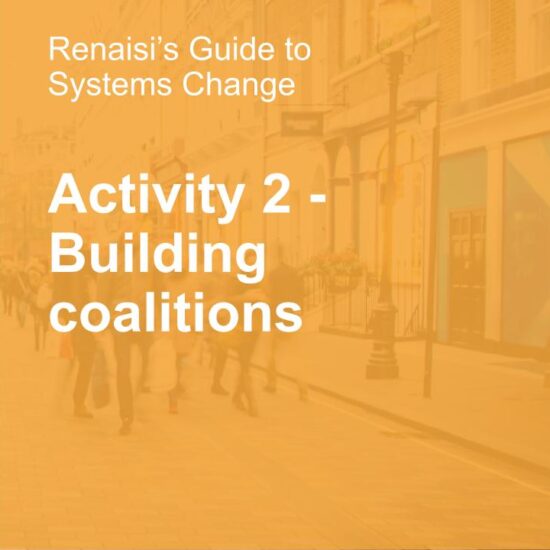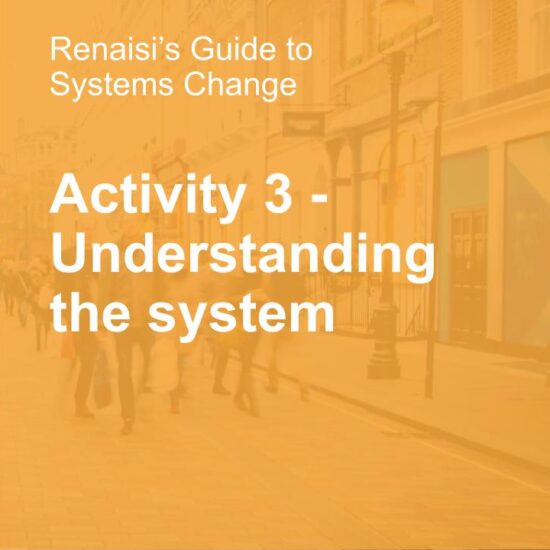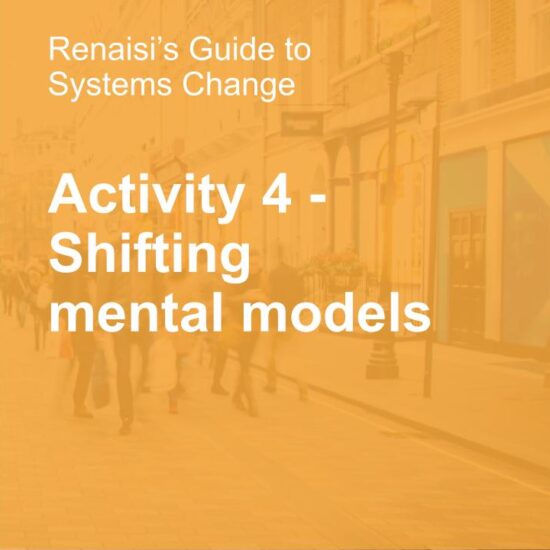Renaisi’s Guide to Systems Change: Activity 2 – Coalition Building
This is the second activity in Renaisi’s guide to systemic change. In May this year, we launched the initial findings of our year-long enquiry into what it takes to change a system. Here, Senior Project Manager in Place and Systemic Change Kezia Jackson-Harman reflects on the overall learning and approach.
Find the Guide to Systems Change here, including examples of this work from our partner organisations.
This guide to systemic change sets out five activities that we have found critical for organisations and partnerships that want to change a system. We know that this journey will look different for each organisation and that the journey won’t be linear. You cannot tick one activity off and move to the next – you will need to continually work on and embed each activity in your work over time. But we do think that there is a clear starting point – and that starting point is yourself.
The article below sets out how we have seen organisations and partnerships progress the second activity in systemic change – Coalition Building.

Activity 2: Coalition
Build empathetic, reflective and trusting relationships underpinned by shared ambitions for systemic change.
Why is this important?
Systemic change does not happen alone.
We know that systems are made up of lots of organisations, individuals and networks, many of whom will experience the system in very different ways. Understanding how a system works requires hearing from lots of different perspectives. Developing interventions that will change a system also requires the buy-in from lots of different actors that are currently perpetuating the status quo.
This activity feels pretty uncontroversial, with many in the social sector now agreeing that collaborative working is a more impactful way to support social change. Many funding programmes that aim at systemic change now requiring applicants to apply in partnership. However, we have found that funders aiming to support collaboration will generally provide resource for organisations to deliver activities together, but overlook the investment needed in the skills and time required for collaboration itself.
Investing in the development of a coalition for change is the next activity that we have found critical to systemic change.
What does it look like in practice?
Having begun interrogating your own role in the system, organisations approaching systemic change should begin to bring other organisations and individuals alongside in the journey.
Start by exploring who is in the system. Build a picture of the people, organisations, groups and services that influence an individual’s experience of the system. We have seen organisations do this both through engaging structured systems mapping processes and more organically through working with others on an issue that requires you to engage with a diverse range of actors in the system.
In this process it is critical to both hear a diverse range of perspectives on the system and uphold the insights and perspectives of those with lived experience of harm. While the funder, local authority or service provider may believe their services are accessible and high-quality, if an individual says they can’t find or access those services, we have to uphold their experience to really understand what needs to change.
As you engage with more and more of the system in this process to understand who is in it, try to bring those you engage together around a shared ambition for systemic change. The process of mapping out the actors and relationships within the system, in a ‘systems map’, should be seen as way to build a coalition, alongside an output in itself. “This focus on coalition building can ensure that systems mapping leaves those involved feeling motivated to drive change, rather than disempowered by having gained a deepened understanding of what is wrong, without a sense of access to or influence over those needed to create change.”
Building this coalition requires developing empathetic, meaningful and intentional relationships. It has to enable partners who are used to competing with each other to come together with a willingness to reflect on what they might be doing wrong and leave their organisational agenda and ways of working behind in the interest of systemic change. For this to happen effectively each organisation in the coalition needs to step into Activity 1.
We’ve seen that coalition building is an ongoing, iterative process and the group will expand as momentum for change builds. We recommend going where energy lies to build a coalition of the willing first, alongside maintaining an awareness of all those influential actors in the system that feel out of reach, or are not yet bought into the ambition for change.
Key questions to unpick in this activity:
- Who are the people, organisations, groups or services that have a touchpoint on a person’s life, and influence their experience of the system you aim to shift?
- Out of this group, who do you believe understands that the current system is not working? (this might include some who currently benefit from the status quo, alongside those that it is harming)
- Who do you have existing relationships of influence with?
- Whose voices need to be heard in order to change the balance of power? And what are the stories we might be telling about ourselves and others that might be (unintentionally) holding problems in place?
- What is driving distrust and competition between actors? How can we leave this aside?
- How can we create spaces and resources that facilitate closer working across organisations?
- How can we navigate disagreements and critique in ways that are generative?
Indicators of change:
- Organisations and individuals view their relationships with others in the system as a tool to influence shifts in practice which feels empowering
- Partnerships develop that go beyond single projects.
- Conversations and interactions in meetings feel different as partners are speaking from themselves rather than from their organisation
- Partners respect others’ experiences, pressures and challenges (including lived experience).
- People feel more comfortable with critique and conflict because it’s underpinned by respect, care and trust in shared goals.
We hope you’ll download and read the full guide, which sets out the full detail of our approach along with examples of this work from partner organisations including Youth Futures Foundation, Black Thrive and Smallwood Trust. which sets out the full detail of our approach along with examples of this work from partner organisations including Youth Futures Foundation, Black Thrive and Smallwood Trust.
For more information, please contact Kezia.

- Want to find out more?
- Contact Kezia Jackson-Harman on:
- 2045244916
- k.jackson-harman@renaisi.com



